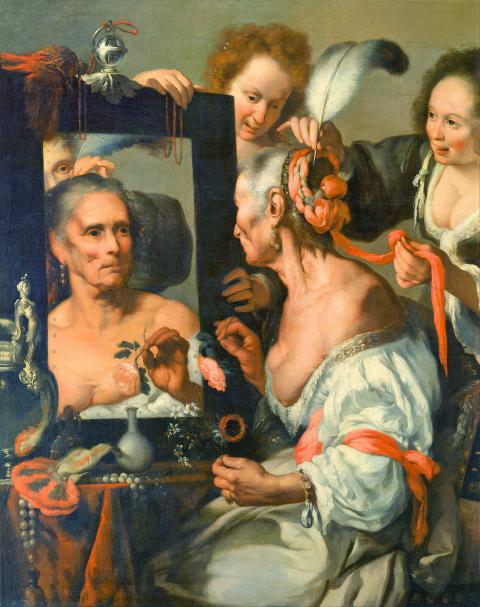Chinese Practice
鏡花水月
(jing4 hua1 shui3 yue4)

Photo: Wikimedia Commons
照片:維基共享資源
flowers in the mirror, moon in the water
在佛教中的概念「色」──梵文為「rupa」,英文為「form」(形式)──指的是地(或固體)、火(或熱)、水(或凝聚力)、風(或運動)等四種基本元素中的一種或多種的存在。所有物質的或有形式的東西,必然訴諸色(視覺)、香(嗅覺)、味(味覺)、觸(觸覺)等至少一種感官。
鳩摩羅什(西元三四四~四一三年)的父親是一位佛教僧侶,來自現今克什米爾,後移居現中國新疆省的龜茲國,其母親則是龜茲國的公主。鳩摩羅什後來定居長安,成為將原為梵文的佛經譯介到中文世界的推手,聲名遠播。慧遠(西元三三四~四一六年)是在中國創立淨土宗的佛教祖師。《遠什大乘要義問答》(又稱《大乘大義章》或《鳩摩羅什法師大義》),為鳩摩羅什和慧遠兩人之間討論大乘佛教的問答錄。
其中,鳩摩羅什闡述了「非色」,也就是沒有形式的東西:「如鏡中像,水中月,見如有色,而無觸等,則非色也」(就像鏡中的影像,或水中﹝反映﹞的月亮;這些東西看似有形,你無法碰觸它們,所以它們沒有形式。「鏡像水月」這說法即由此而來,這也是現今成語「鏡花水月」的原始形式,用來描述虛幻或無實體的東西。成語「鏡花水月」也是李汝珍一八二七年的神魔小說《鏡花緣》書名的靈感來源。
在英文中,所謂透過「rose-colored glasses」或「rose-tainted spectacles」(玫瑰色眼鏡)來看世界,是指看待人生的眼光很正面,而到了太過理想化、太天真的程度。因此,它是在暗示這樣的人並沒有完全正確地看待這世界。
這說法初次使用的時間和地點,我們不得而知,但目前所知,在十九世紀五○年代前就已在法文和英文書中出現。意為玫瑰色的形容詞「rosy」──可能來自古法語,以及「rose-colored」,自一五九○年代起便用來表示健康的氣色;一七○○年代起意指「充滿希望的」或「樂觀的」,而自一八八七年起則意指「有前途的」。
愛爾蘭旅行作家瑪麗‧博丁頓一八三四年著《Slight reminiscences of the Rhine, Switzerland, and a corner of Italy》(萊茵河、瑞士和義大利一隅的回憶),在第二卷中,她用了以下這句話來指陽光的性格和積極的人生觀──這特質是我們年輕時所擁有,成年後只要我們願意,仍可繼續保有:
「噢如花綻放生命的喜悅!年輕、能透過玫瑰色眼鏡來看一切是多麼棒的事;我們可以長久持續用玫瑰色眼鏡來看世界,只要我們開開心心、樂觀快活,我們比想像中還要有能力做到。」
美國一八四三年版的《Godey’s Lady’s Book》(姑蒂淑女雜誌)中,有個故事題為〈The Ideal and the Real〉,作者瑪莉‧黛芙南以更為批判的方式來用這句話,暗示所談及的人天真、不如說這話的人能看清事實:
「戀愛中的男人很容易上當受騙。親愛的,我比你見過的世面還多,只因為我用自己的眼睛去觀察別人,而不是像你一樣用玫瑰色的眼鏡……」
最後,一八四一年由帕斯卡雷所編的法國文學評論中,有這麼一句說法「l’optimiste souriant qui regarde la vie a travers des lunettes roses」(透過玫瑰色眼鏡來看人生的微笑的樂觀主義者)。
因此,這個片語有可能根本不是源自英文,雖然並非絕對如此。
(台北時報林俐凱譯)
功名利祿只不過是鏡花水月,不值得你犧牲一切汲汲營營。
(Social status, fame and fortune are illusionary, they’re not worth sacrificing everything for.)
英文練習
see the world through rose-colored glasses
In Buddhism, the concept of se 色 — “rupa” in Sanskrit, “form” in English — refers to the presence of one or more of the four primary elements of earth (or solidity), fire (or heat), water (or cohesion) and air (or movement). Everything that is material, or has form, necessarily has at least one appeal to the senses: sight, smell, taste or touch.
Kumarajiva’s (344-413) father was a Buddhist monk from present-day Kashmir who moved to the Kingdom of Kucha in present-day Xinjiang Province in China; his mother was a Kuchan princess. He settled in Changan and made a name for himself translating Buddhist texts from Sanskrit to Chinese. Huiyuan (334–416) was a Chinese Buddhist teacher instrumental in establishing the Pure Land Sect in China. The collection yuanshi dacheng yaoyi wenda (Correspondence on the Essentials of the Mahayana), also known as the dacheng dayi zhang (On the Meaning of the Mahayana) or the jiumoluoshi fashi dayi (Kumarajiva’s Great Exposition of Meaning) is the record of discussions on Mahayana (Greater Vehicle) Buddhism between the two men.
In this text, Kumarajiva expounds on things that have no form, saying 如鏡中像,水中月,見如有色,而無觸等,則非色也: “Just as the image in a mirror, or [the reflection of] the moon in water; these things appear to have form, and yet you cannot touch them, and so they have no form.” From this we get the phrase 鏡像水月 (reflection in the mirror; moon in the water), the original form of the modern Chinese idiom 鏡花水月 (flowers in the mirror; moon in the water), used to describe something that is illusionary or insubstantial.
The idiom inspired the title of Li Ruzhen’s 1827 fantasy novel 鏡花緣 (The Marriage of Flowers in the Mirror).
In English, the idea of seeing the world through “rose-colored glasses” or “rose-tainted spectacles” refers to the attitude of somebody who views life in a positive light, generally to an overly idealistic or naive degree. It suggests, then, that the person is not viewing the world entirely accurately.
It is unknown exactly when and where the phrase was first used, but it is thought to date from just prior to the 1850s, with French and English versions in print from around that time. The adjectives “rosy” — possibly from Old French — and “rose-colored” have been in use from the 1590s in the sense of a healthy complexion, since the 1700s in the sense of “hopeful” or “optimistic” and in the sense of “promising” in a reference from 1887.
In the second volume of her Slight reminiscences of the Rhine, Switzerland, and a corner of Italy from 1834, the Irish travel writer Mary Boddington uses the phrase to refer to a sunny disposition and positive outlook on life, that we have when young but can maintain through adult life, should we want to:
“O the joy of blossoming life! What a delicious thing it is to be young, and to see everything through rose-coloured glasses; but with a wish to be pleased, and a certain sunniness of mind, more in our power than we imagine, we may look through them a long time.”
In an 1843 edition of the American publication Godey’s Lady’s Book, a story entitled The Ideal and the Real by one Mary Davenant uses the phrase in a more critical way, suggesting that the interlocutor is naive, and not blessed with the clearer discernment of the speaker:
“A man in love is easily deceived. I have seen more of life than you have, my dear, simply because I look at people with my own eyes, instead of through rose-coloured glasses as you do...”
Finally, an 1841 French review of literature, edited by one E. Pascallet, has the phrase “l’optimiste souriant qui regarde la vie a travers des lunettes roses” (the smiling optimist who looks at life through pink glasses).
It is not necessarily the case, therefore, that the phrase has its roots in English at all.
(Paul Cooper, Taipei Times)
I’m not as optimistic as Bob is. He always looks at the world through rose-colored glasses.
(我才不像巴布這麼樂觀,他老是那麼天真無知。)

A: What types of fruit enzymes should we take to help reduce eye floaters? B: According to a study published in the “Applied Sciences” journal by Taiwanese ophthalmologist Horng Chi-ting, pineapple, papaya and fig supplements can improve symptoms. A: Pineapples are in season now, so you should munch on more of those to get rid of floaters. B: Not quite. Enzymes can be damaged by our stomach acid if we eat the fruit directly. The doctor says taking fruit enzyme capsules is better for absorption. A: Most importantly, we should reduce our use of personal electronics to prevent floaters from

Rice is essential to Japanese culture, tradition and politics. People take pride in the oval-shaped sticky Japonica grain, which is still a staple even though total consumption has fallen over the decades. But since last summer, prices have soared as supplies have fallen short of demand. The government has long paid farmers to cut back on rice acreage, and change to other crops to keep rice prices relatively high. To cope with shortfalls this year, the government has released rice reserves. But the grain has been slow to reach supermarket shelves. Anger over that was part of the reason the Agriculture Minister

In Taiwan, 7-Eleven convenience stores can be found on almost every street corner. With over 84,600 stores across 20 countries, 7-Eleven has more locations than any other retail business on Earth. For millions of people, the chain is an important part of daily life, providing coffee, quick meals, and essential items for those __1__. The history of 7-Eleven began nearly 100 years ago in Dallas, Texas. In 1927, the Southland Ice Company began selling blocks of ice that were used to keep fridges cool. Shortly after opening, the company __2__ its offerings to include groceries like milk, eggs, and

Continued from yesterday(延續自昨日) https://www.taipeitimes.com/News/lang In 1946, the company adopted the name 7-Eleven to reflect its newly extended __3__, from 7am to 11pm, a novel concept at the time. As a rapidly growing company, it began offering franchise opportunities in the 1960s. In 1974, the first 7-Eleven in Japan was opened by the supermarket company Ito-Yokado. The Japanese franchises were __4__ successful that by 1991, Ito-Yokado was able to acquire a 70 percent stake in Southland Corporation. Its investments eventually resulted in full ownership of 7-Eleven, which paved the way for the Japanese company to enter the international market. Since then, 7-Eleven